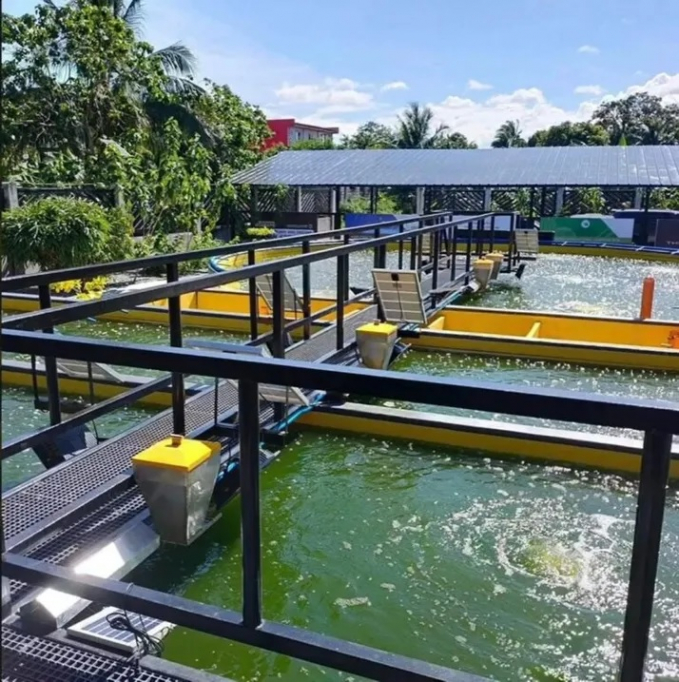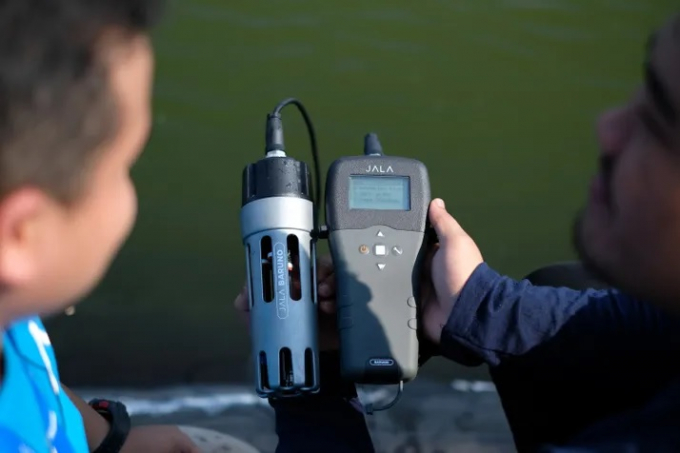November 25, 2025 | 12:30 GMT +7
November 25, 2025 | 12:30 GMT +7
Hotline: 0913.378.918
November 25, 2025 | 12:30 GMT +7
Hotline: 0913.378.918

Modern equipment and the latest technology may not be suitable for all aquaculture operations. Photo: Neil Quijano.
Auto-farming using sensors and artificial intelligence, seeking aid through the internet and Big data systems are seen as the next premise in sustainable production to meet future seafood demands.
Modern urban fish farms are much smaller in size but can achieve a production volume of 58 times more than traditional farms.
Traditional farms can produce 34 tons of fish/ha/year, but with the right technology, next-generation farms can harvest up to 2,000 tons/ha/year in climatic, indoor, biosafety and antibiotic-free environments.
Smart farms are more energy efficient. One kilogram of fish may require only 1.5 kW of electricity to produce while conventional systems may use 25 - 30 kW. Recent advances in genetics, nutrition and other techniques have made it possible for farms to produce more with less waste of resources.
But farmers must take into account the key factors before investing in new technology. Modern equipment or latest technologies may not be for everyone. To achieve success, fish farmers must first grasp the implementation cost of these technologies.
According to Matthew Tan, associate professor (A/Prof.) of aquaculture at James Cook University (JCU), Singapore Representative (Private Sector) - APEC Policy Partnership on Food Security, aquaculture is “a very profitable industry".
A/Prof. Tan stated that fish farmers should understand the financial model before moving to Aquaculture 4.0. “Look at the market first, and ask questions: Who is buying? What is the price of the fish? What is the cost of implementing the technology?”
Aquaculture 4.0 is an aquaculture industry adapted to the Fourth Industrial Revolution (Industry 4.0). Aquaculture 4.0 is defined by today's trend of smart automation, linkage and other groundbreaking technologies.
A/Prof. Tan added that for each additional upgrade in equipment or technology, additional costs must be put into consideration to determine whether it is worth pursuing/adopting.
He shared an example of his experience running an abalone hatchery in China, where it cost 3-4 cents to produce one baby abalone. “Implementing a new technology costs me 4 cents more means having to cost 8 cents just to produce a baby abalone. I won't use that technology because my selling price is only 6-7 cents.”
He concluded that only when the production costs are lower while the underwriting and selling price are well-maintained will the new technology makes sense, not only in the aquaculture sector but also in other economic fields.

Each additional upgrade in equipment or technology, additional costs must be put into consideration to determine whether it is worth pursuing/adopting. Photo: JAJA.
On the other hand, he said that high initial investments in modern aquaculture "hold more meaning in terms of finance".
A/Prof. Tan is researching indoor super-intensive shrimp farms at the moment. He admits that this model will be more expensive to set up than open ponds. But considering the risk of disease outbreaks in shrimp, closed systems with high biosecurity may be a better option.
“Open-pond farmers always think that shrimp is much cheaper, thus making more profit. But if you take into account all the losses when the disease hits, they will see that it is actually a massive loss," A/Prof. Tan said.
Mr. Francis Neil Quijano, Founder of Agritektura Diversified Company, mentions how new technology and equipment can reduce electricity costs, especially in the Philippines, where electricity-intensive recirculating aquaculture systems (RAS) are struggling to further develop.
“We are using old technology in the Philippines, for example an aerator that has a minimum wattage of one horsepower and requires 745 W. Now we are using a better, energy-efficient aquarium tank which consumes approximately 165 W. This can make RAS come closer to the realm of achievable feats.”
Mr. Quijano said that while fish farmers are still using technologies of the 1990s, he has the opportunity to witness more up-to-date technologies which were introduced in late 2020 thanks to working with other professionals, including those from outside the Philippines.
“Let's start with working with different professionals and experts. Not only modern fish farmers, but architects, engineers, and researchers should all work together. Embrace new technologies, which I know will work well in the Philippines,” he said.
Translated by Samuel Pham

(VAN) Heavy rains make aquatic species more vulnerable to disease. Proactive water management and high-tech systems help farmers prevent outbreaks and protect yields.

(VAN) Greenhouses are shifting production mindsets in Binh Lu commune, enabling farmers to ‘weather the sun and rain’ and secure stable vegetable harvests throughout the year.

(VAN) Green transition is crucial for the Mekong Delta amid climate change and stricter standards, offering a path toward sustainability.

(VAN) Dong Thap promotes agricultural restructuring, forms large specialized farming zones, raises the value of agricultural products and develops toward ecological and high-tech directions.
/2025/11/22/4018-4-213342_747.jpg)
(VAN) The Mekong Delta Agricultural Experts Club has attracted 143 experts and researchers to participate in providing consultancy and contributing initiatives to the development of one million hectares of high-quality rice.

(VAN) Ca Mau’s development of OCOP products opens a path to increasing cooperatives value, helping boost income, expand markets, and affirm collective economy's role.

(VAN) Turning seemingly ordinary coconut shells into unique jewelry and artwork, Nguyen Bang Nhi spreads the value of local culture through her brand, Cocohand.